Hello! We’re refreshing our website as you browse. If something feels off, just reach us at +91-8088313131 or experience@artflute.com.
Reach out to us on +91-8088-313131 or experience@artflute.com if you face any issues.
Hello! We’re refreshing our website as you browse. If something feels off, just reach us at +91-8088313131 or experience@artflute.com.


S H Raza
S H Raza's art is fundamentally a celebration of nature whether it appeared in his early expressionist watercolour landscapes from the 1940s, the Cubist compositions from his stay in Paris, or his later abstract works distinguished by the fusion of geometric forms with spiritual concepts. His themes frequently drew inspiration from his early years spent playing in the forests of his native village in Madhya Pradesh. The artistic development of Raza over the course of over eight decades reveals the life of an artist and person who consistently pushed the limits of modern art as well as his own.

S H Raza
Contemporary Artist
![[object Object]](/_next/static/media/profilearrow.f3172fa3.svg)
About Artist
Sayed Haider Raza, a renowned 20th-century painter born in 1922 in Madhya Pradesh, India, found inspiration in his childhood memories of the dense forests and vibrant village life. As a founding member of the Progressive Artists Group, he embraced modern Indian art rooted in cultural heritage. Moving to France in 1950, he studied at École Nationale supérieure des Beaux-Arts, eventually settling in...Read More
His accolades included the Prix de la critique, Padma Shri, Lalit Kala Akademi Fellowship, Padma Bhushan, Padma Vibhushan, and Commandeur de la Legion d'honneur. Raza established the Raza Foundation to promote Indian art and culture, supporting emerging artists and organizing exhibitions. Despite his wife's passing, he continued painting passionately until he died in 2016. The Centre Pompidou hosted a retrospective exhibition of Raza's works, titled "Raza: The Fullness of Abstraction," showcasing his renowned pieces alongside photographs and documents, marking a significant showcase of his life's work in France.
Here are some quick access collections to Raza's works:
Bindu Series by Raza
Explore Raza's journey with 10 of his works
Serigraphs of Husain, Raza and Thota Vaikuntam
The Bindu and Beyond
Sayed Haider Raza’s artistic journey spanned from rural India to global recognition. A founding member of the Progressive Artists' Group (PAG), Raza pushed boundaries, blending Indian traditions with modernist ideas. His style evolved from Cubism in the 1950s to expressive abstraction in the 1960s, culminating in the iconic "bindu" in the 1970s, symbolizing the core of creation. Throughout his career, Raza sought to connect deeply with nature, spirituality, and his Indian roots. He also embraced serigraphy, making his art accessible to a wider audience, ensuring his legacy reached beyond galleries.
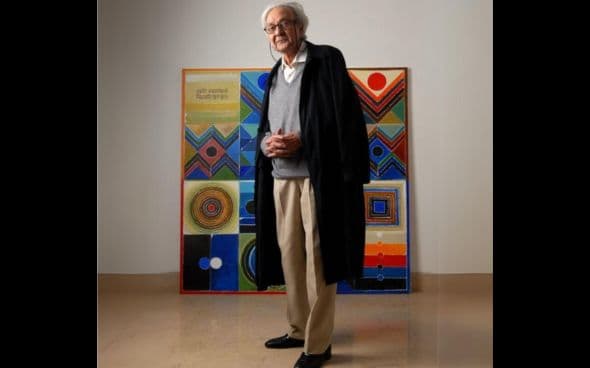
Roots in Abstraction
Sayed Haider Raza wasn't your typical artist. This Indian modernist took the road less taken from what was dominant back in his days - figurative art - opting instead to make a move towards abstraction as his career progressed. His canvases burst into geometric abstract shapes and colours, inspired by his homeland's rich spiritual and philosophical traditions, particularly Tantric tradition that employed art as a device to catalyze the transformation of consciousness. Raza started with landscapes and cityscapes, but his true passion was exploring the connection between nature, the universe, and our inner selves. He used the "bindu," a simple dot symbolizing the core of creation, as a recurring motif. Inspired by his childhood surrounded by Indian forests, his art blended the influences of Rajasthani and Pahari miniature paintings, poetry, and meditation practices. Even living mostly in Paris, Raza's Indian roots shone brightly through his masterful use of colour.
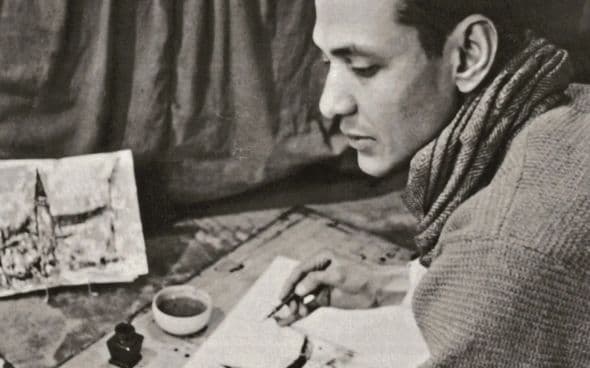
The Art of Tranquility
Born in 1922 in rural Madhya Pradesh, Sayed Haider Raza defied easy categorization as a mere landscape artist. He spent his childhood surrounded by the dense forests of Kanha, but his artistic expression went far deeper than mere scenery. Raised with values of discipline, helpfulness, and individual pursuit, Raza's upbringing instilled a lifelong respect for nature. It wasn't just a pretty view; it was a profound teacher. From the vibrant colours to the sheer vastness, nature's lessons permeated his art. Most notably, a childhood memory of a teacher using a dot to calm his mind found its way into his artistic repertoire - what we see as the "Bindu" as the focal point in most of his works is in fact stemmed from this memory.
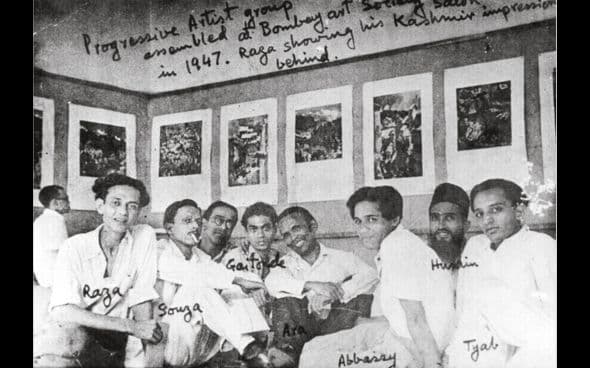
The Progressive Path
Driven by his passion for art, Raza landed in Bombay and enrolled at the prestigious J.J. School of Arts. Graduating in 1947, his artwork caught the eye of other young artists like F.N. Souza, K.H. Ara and others. Together, on account of Indian independence in 1947, they formed a revolutionary group: the Progressive Artists' Group (PAG). The PAG rejected the colonial-era art styles that dominated before them. They weren't interested in recreating "true Indian art" as some described it. Instead, they wanted to explore what the new identity for a newly independent India might look like. They looked back to their own rich artistic traditions and philosophies, but also embraced a global outlook. They were curious about Western art, but didn't want to simply derive from it. The PAG was all about forging a unique path for Indian art in the modern world.
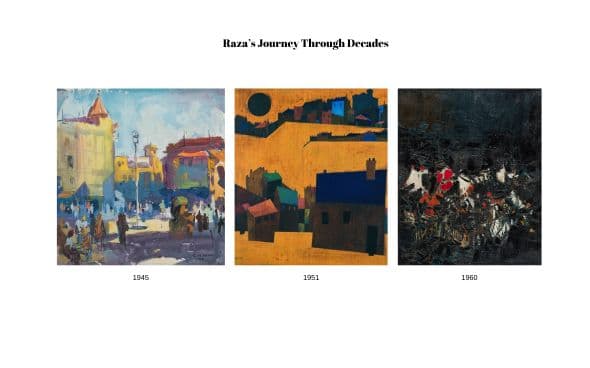
From Bombay to Paris
In 1948, The PAG's first group show in Bombay was a hit, setting the stage for the onset of Indian Modernism. It was a great year for Raza too - he met the famous French photographer Henri Cartier-Bresson. Cartier-Bresson saw potential in Raza's work but suggested he add more structure, recommending the art of Paul Cézanne. Feeling inspired, Raza travelled to Paris on a scholarship and spent years refining his skills at Ecole de Paris. This move to France marked a turning point in Raza's artistic journey. With the way his works progressed and which proved to be a turning point in his life, in the year 1956, he was the first non-European artist to receive the Prix de la Critique. Followed by which, he got married to French artist Janine Mongillat in 1959, who was very much instrumental in his artistic freedom and artistic fulfilment.
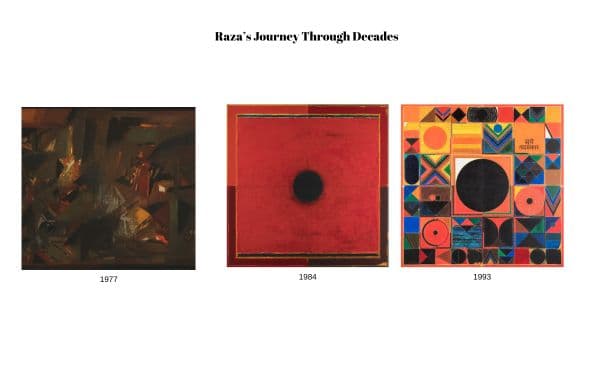
The Birth of Bindu
1950s: Fresh from India, Raza found inspiration in the French landscape. His paintings took on a distinctly Cubist style, emphasizing order and structure in form and composition. 1960s: A shift began. Raza moved away from Cubism towards a more fluid and expressive style. He gradually abandoned figures, landscapes, and the careful compositions of the previous decade, favoring bold gestures on canvas. In these works, the lines between foreground and background blurred, creating a unified whole. Even his medium changed from oil to acrylic. These gestural paintings brimmed with emotion, vibrant movement, and rich colours. The colours themselves transcended mere decoration; they held an emotional charge. Late 1970s: A new focus emerged – pure geometric forms. Raza's paintings became improvisations on a central theme: mapping out a metaphorical space within the mind. This period also saw the birth of the iconic "bindu," a single, meditative form that would become synonymous with his art. The bindu marked a turning point, leading him towards the pure geometric abstraction that defined his later years. In the later stages of his career, a deep longing for India, the country that had nurtured his artistic spirit, began to resurface in Raza's work. He turned his focus to capturing the essence of his homeland, the vibrancy and unique character of India, in all its glory.
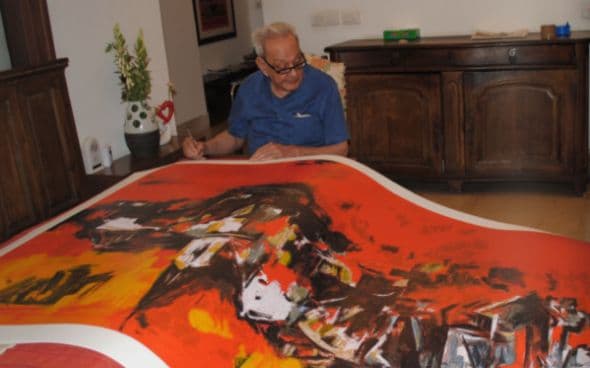
Serigraphic Exploration
While at that, he was no stranger to the upsurge in serigraphy's potential in the Indian market either. At the time, he, among the top leading artists of India, came together in making their art more accessible to have a reach far and wide. Here is him, examining the intricacies of one of his serigraphs.
























.jpg&w=3840&q=75)









